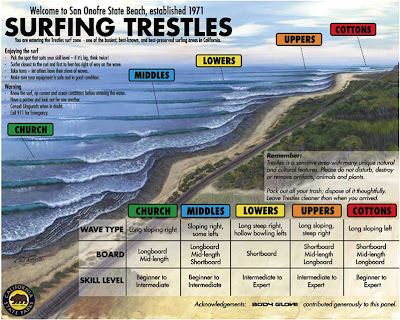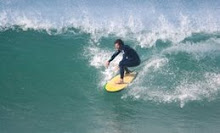
Jeff Spicoli, one of Sean Penn's early roles, has become one of the most recognizable characters in surf movie history. Spicoli epitomized the ultimate surfer stereo type - he was a perpetually stoned surfer who could care less about school or the rules.
As Spicoli put it, "All I need are some tasty waves, a cool buzz, and I'm fine."
This entertaining Hollywood character may have done more to perpetuate the surfer stereotype and done more damage to the reputation of the surfers than any other characterization.
Today's surfers around the world, many of whom are extremely successful professionals, are responsible parents or highly paid professional athletes still suffer from this negative stereotype.
While we still have a long way to go, the good news is that things are changing as surfing become more mainstream (at least there is an upside) and there is less bias towards surfers.
Sunday, November 4, 2007
Spicoli
Posted by
Chad Nelsen
at
9:22 PM
|
![]()
Labels: spicoli, surfer stereotype
Wednesday, October 24, 2007
Surfer Stereotype Dispelled in Pismo Beach

Yesterday, I gave a talk at the H20 Conference entitled Dispelling the Surfer Stereotype based on my research on the socioeconomics of surfing at Trestles Beach in Southern California.
Ted Ehring, a councilmember of the City of Pismo Beach, was in attendance and he commented that while Pancho's Surf Shop was a leading contributer to the City's tax base, he was under the impression that surfers didn't really contribute much to the economy of his coastal city. He was startled to hear that I estimated a range of economic impacts to the City of San Clemente by surfers who visit Trestles to be between 8 and 13 million dollars a year. He requested a copy of my power point to share it with others.
I guess it worked- for a least one person the surfer stereotype was dispelled.
Posted by
Chad Nelsen
at
8:01 AM
|
![]()
Labels: economic impacts, surfer stereotype
Wednesday, October 10, 2007
What is your $urf $pot Worth...

What is your surf spot worth? For most surfers the immediate answer is that a surf spot, especially a good one, is priceless. How can one put a value on the mystical connection with nature, the mental healing, the adrenaline rush, and the good times spent with friends in the line up?
While many would agree that attempting to put a dollar value on a wave is sacrilege, in this increasingly market-driven, capitalistic world we live in explaining the value of waves with dollars and cents may be one of the best tools wave have to protect and save waves.
This is a blurb from an article I wrote for Surfshot's Ecologic column.
You can read the whole thing here
Posted by
Chad Nelsen
at
8:33 PM
|
![]()
Friday, October 5, 2007
Who cares about surfing?
Hi Chad,
Stoked that you've set this blog up. I look forward to chewing the fat on a few big questions. Let me start with one. Something that bothers me a bit is the 'so what' question. What will we be able to do once we have the info that tells us surfing and the surfing lifestyle is worth heaps to a particular town or region?
For example, everyone knew that Kirra was the best surfbreak in Oz, yet it didn't stop the government dumping millions of cubic metres of sand on the break to the point that it hasn't broken in over 10 years. The act of parliament that governed the project to bring sand across the border even stipulated that recreational amenity was a key priority. Even when they knew that the break was being destroyed it was ok to trade of Kirra for something else.
So what will we do with the information we collect? Will politicians and bureaucrats listen to us because we can now demonstrate that we are significant economic stakeholders in the coastal economy? Will dollars alone save surfbreaks or do we need something more than that?
Posted by
Neil Lazarow
at
12:53 AM
|
![]()
Wednesday, October 3, 2007
Welcome to Surfing Economics

All of a sudden it seems that there are a bunch of folks around the world that are using economic methods to try and better understand the values and uses of surfing areas. There are studies underway at Trestles, Mundaka and Australia to name a few.
This new blog is dedicated to communicating the application of economic and socioeconomic techniques to better understand the uses and values of surfing areas.
Posted by
Chad Nelsen
at
9:32 PM
|
![]()


